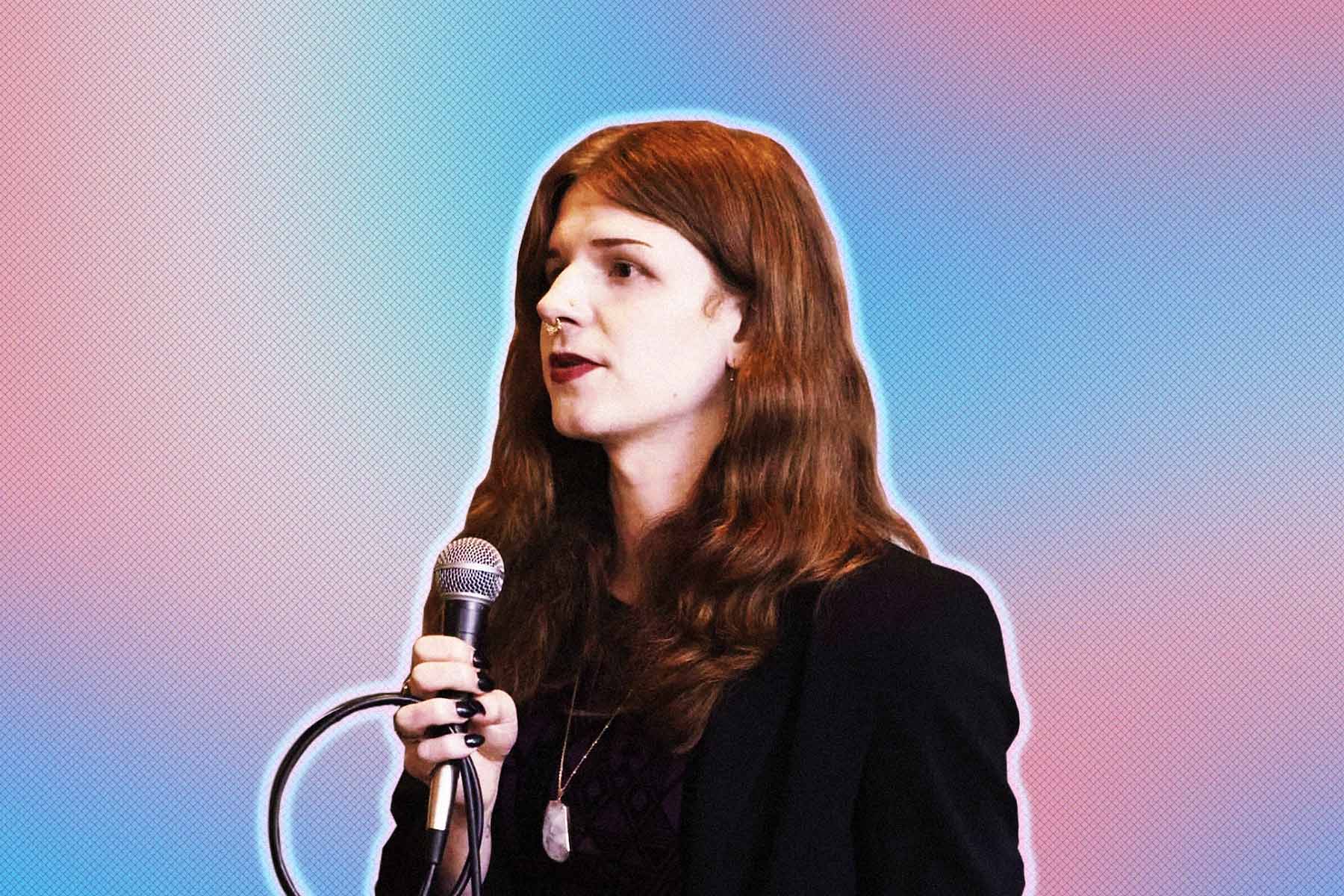In early March, I was featured on a Hershey Canada limited-edition chocolate bar for International Women’s Day. I was humbled to be a part of the ad campaign and hoped my inclusion would send a message about celebrating women in all our diversity.
Instead, it sparked a global campaign to boycott the company. Within days, I was targeted by figureheads of the American far right. Matt Walsh deadnamed me and called me a “vile, woman-hating extremist” to his 1.8 million Twitter followers. Brett Cooper dug up my pre- and early transition photos. Tucker Carlson—then still on Fox News—mocked me with out-of-context quotes from my Twitter and Instagram feeds and equated me with fascists. The day after Michael Knowles broadcast a segment about how “Hershey’s Transes Their Chocolate” on his Daily Wire show, he gave a speech calling for the extermination of “transgenderism” from public life.
The coverage was relentless. Scores of articles appeared in right-wing publications, and thousands of obscene messages poured into my Twitter mentions, DMs, and email inbox. Memes and caricatures of me were shared on social media. I was called a fag, tranny, groomer, and paedophile. I was encouraged to kill myself and threatened with physical violence.
This is the fourth time I’ve been targeted in the past ten months. After I was mentioned in a speech in August by the minister for women and gender equality and youth at the launch of the Federal 2SLGBTQI+ Action Plan, Sue-Ann Levy wrote an article, in True North, a right-wing Canadian digital media platform, about how Justin Trudeau is “appeasing radical trans activists.” Because I agreed to speak at a college campus to commemorate the 1989 mass shooting at École Polytechnique, an anti-trans blog accused me of “manhandling” the Montreal massacre. Last month, after learning I was headlining a Saskatchewan awards gala held by a women’s organization, Rebel News launched a petition demanding that my invitation be rescinded, calling it “an insult to the 600,000-plus women and girls in Saskatchewan.”
These are but a few examples among many. With every new attack, it gets worse—louder, angrier, more personal. It’s no longer just fringe groups driving the message. The hate is also penetrating bigger spheres. Politicians across North America are making discrimination a platform; writers and cultural figures are adopting its ideas. 2SLGBTQIA+ communities have warned about this escalation for years. And now we’re at a precipice: anti-queer and anti-trans rhetoric is being increasingly mainstreamed, and if something doesn’t change, it’ll sink into our cultural fabric and further jeopardize the safety, inclusion, and rights of our communities. There’s no reason to believe it’ll stop with us.
Life as a trans person can be excruciating enough as it is. Compared to the general population, we are far more likely to experience physical or sexual abuse over our lifetimes. We are also more likely to be trapped in severe poverty and homelessness. Harder to address, and often more frightening, is the fear mongering. Across Canada and around the world, we are witnessing a sharp rise in anti-2SLGBTQIA+ hate, accompanied by efforts to roll back human rights protections, inclusive policies, and equity initiatives. The United States has been ground zero for this anger. Over the past three years, certain states have sought to ban access to gender-affirming health care and introduce archaic “Don’t Say Gay” laws. In 2023 alone, according to the Trans Legislation Tracker, 549 bills seeking to restrict trans rights have been introduced across legislatures. As of this month, sixty-six have been signed into law.
In Canada, we already see the warning signs: protests targeting drag events, rhetoric equating trans people to paedophiles, and so on. From 2020 to 2021, we saw a 64 percent increase in hate-motivated violence targeting queer communities. And that’s just in the police-reported data. For communities historically subjected to mistreatment by police, and therefore less trusting of law enforcement, the reality is likely worse than these figures indicate.
But there is another number that reflects how outsized the panic about trans people has become. Census data for 2021 shows we make up less than 1 percent of the population. We are not a threat to any person or anyone’s fundamental rights. What we are, however, are communities subjected to a staggering degree of dehumanization. Trans and queer people come from a long tradition of being reviled as freaks and deviants. In the past decade, we’ve seen a laudable improvement in trans representation, but we’re still ridiculed in media, made into sources of comedic relief in films, described as paedophiles and depicted as such, and treated as psychiatric “problems” to be “solved.”
These tropes live in the collective consciousness. And the far right—a tribe that includes fringe political parties like Maxime Bernier’s People’s Party of Canada, white supremacists, pro-life and anti-queer Christian evangelicals, men’s rights activists, and COVID-19 conspiracists—have recognized they can tap into that dark legacy. Gender Dissent, a publication popular among Canadian anti-trans groups, alleges trans rights is a “big pharma” scheme pushed by George Soros. According to this conspiracy theory, recent increases in the percentage of people who identify as trans are part of a “social contagion” driven to raise profits for pharma companies providing trans people with hormone medication. Thanks to anti-trans messaging, fear that “gender ideology” has taken over schools, institutions, and workplaces is rampant. Examples of trans people committing violence are being used to radicalize people against us, even as trans people are massively more likely to be the victims, rather than the perpetrators, of crime. In the eyes of anti-trans groups, any effort by nonprofits, governments, or corporations to advance trans inclusion—like using people’s chosen names and pronouns—is framed as caving in to a radical agenda.
Maybe the most effective way trans hate is being exploited is as a wedge issue, one that emboldens far-right groups to push aside nuance in a broader rejection of “woke” culture. We see this already in the US: a coordinated attack on trans rights arose alongside states’ removal of reproductive freedoms and attempted reversals of gay marriage rights. Far-right groups targeting trans people are also targeting efforts to advance equity for Black, Indigenous, and racialized communities, in part by fuelling efforts to roll back “critical race theory” in schools (code for eliminating anti-racism initiatives).
These far-right groups are all cut from the same cloth. They pontificate on free speech but have no qualms about weaponizing their platforms to bully, troll, and torment individuals whose message they don’t like. Libs of TikTok, a right-wing social media influencer, routinely uses out-of-context clips to incite violence toward 2SLGBTQIA+ people. These tactics have led to bomb threats against hospitals that provide care to transgender kids and teens. Such attacks not only try to mobilize the public against us, but they’re also intended to make us hate ourselves. To live in my new normal—always on guard for the next encouragement to kill myself, the next allegation of paedophilia, the next insinuation that I favour child abuse—is an ongoing trauma.
This, in turn, raises the cost for any individual who speaks out for human rights and social justice. In my work, I field a fair number of media inquiries. I often redirect them to more appropriate spokespeople. For the first time in ten years, I am seeing queer and trans people reassessing the risk of expressing themselves as too high. One local trans youth group in Ottawa is turning down all requests for media appearances, regardless of the source or context, because of the associated dangers. I don’t blame them. Kaedan Seaburn was attacked for advancing trans inclusion at an Ottawa school board meeting; in Regina, Cat Haines was targeted for her art, her academic research, and for creating a trans youth mentorship program; in Calgary, Marni Panas was mobbed online for speaking on an International Women’s Day panel. We need to push for more representation—visibility engenders understanding—but we also have to ensure the safety of visible trans people.
To do that, we need allies. “I’ve said for years that if we’re going to be a priority for our enemies, we need to be a priority for our friends,” Gillian Branstetter, a communications strategist with the American Civil Liberties Union, recently told Vice News. “We cannot fight this off on our own. We need people to hold the line on our own humanity.” But, too often, instances of anti-trans hate are treated as anomalies, one-offs of intolerance in a larger story of inclusivity. They’re not. Our naïveté about Canada’s supposed progressiveness blinds us to how the anti-trans movement exemplifies the broad coalition the far right has built and its ability to influence our social and political spheres. If this coalition can force trans people out of public life and create a hostile environment for them, they can do it to others. Too many outside our communities aren’t making the connection.
This isn’t a battle just for trans rights. It’s a battle for who we want to be as a society. Do we want to move beyond transphobia, misogyny, colonialism, and racism to imagine a more equitable future? Or will we re-entrench stigma, foster intolerance, and permit the demonization of marginalized groups? I hope we have the courage to choose the first option.





